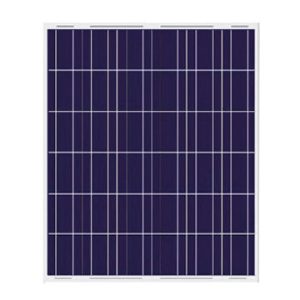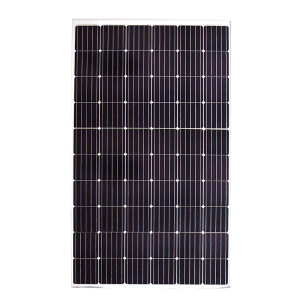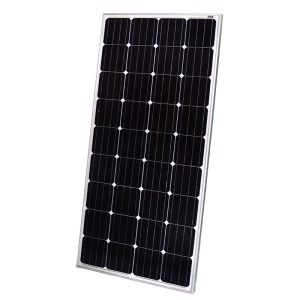Solar panels are rated based on their wattage, which indicates how much power they can produce under ideal conditions. A 320-watt solar panel has a power output capacity of 320 watts. But when looking at how to connect solar panels or what size charge controller is needed, it’s important to know the amperage (amps) that the panel will supply. So how many amps does a 320-watt solar panel produce?
The short answer is that a typical 320-watt solar panel will have a current output of around 9–10 amps at peak power production. To determine the amps, you take the rated wattage of the panel (320W) and divide it by the voltage it operates at when producing maximum power, known as the “maximum power voltage,” or Vmp.
For example, the Renogy 320W Monocrystalline Solar Panel has these specifications:
- Power (Pmax): 320W
- Voltage at Pmax (Vmp): 33V
- Current at Pmax (Imp): 9.79A
So for this 320W panel, the calculation would be:
Power (Watts) = Voltage (V) x Current (A)
320W = 33V x Current
Current = 320W / 33V
Current = 9.7 Amps
Therefore, at peak output, the 320W Renogy panel produces 9.7 amps.
Why Current Changes with Conditions
The current, or amperage, produced by a solar panel varies based on conditions like sunlight intensity and temperature. Under ideal test conditions (25°C cell temperature, 1000W/m2 solar irradiance), a panel will reach its rated power (320W for this example). But in real-world conditions, the current can be higher or lower.
For example, on a very hot day, the solar cells may reach 60°C. The increased heat causes the voltage (Vmp) to drop slightly. To still reach 320W, the current will increase proportionally. So the panel may produce around 10 amps in this scenario.
Conversely, on a cloudy or cool day, the panel voltage and current will both drop, sometimes reducing power output by 50% or more. So current production is dynamic and ranges widely in real-world conditions based on environmental factors.
Connecting Panels to 12V Battery Banks
When solar panels are used to charge batteries in an off-grid solar system, multiple panels are generally connected in parallel.
For example, a lead-acid battery bank may operate at 12 volts. A single 320W panel produces over 30V, which is too high for the 12V battery. So two or more 320W panels are connected in parallel to produce the correct voltage while allowing the currents (amps) to add together.
For instance, with two 320W panels in parallel, the voltage stays around 33V to match the Vmp of each panel. But the panel currents (9.7A for this example) add together for around 19.4 amps of total charging current. This configuration allows the panels to efficiently charge a 12V battery bank.
A solar charge controller is always required when connecting solar panels to batteries to regulate the charging process and prevent overcharging or damage. Some charge controllers operate at 12V, 24V, or 48V nominal for compatibility with different battery bank configurations.
Calculating Solar Panel Amperage
In summary, for any wattage solar panel, you can determine the rated current output (amps) using this simple formula:
Rated Amps = Rated Watts / Voltage at Maximum Power
So for a 320-watt panel with a Vmp of 33V:
Amps = 320W / 33V
Amps = 9.7 Amps
The amps produced will then vary in real-world conditions based on solar irradiance, temperature, shading, and other factors. Panels connected in parallel to batteries or loads will add up their individual currents. So two 320W panels in parallel would produce around 19.4A charging current at 12V nominal.
Understanding solar panel amperage helps determine what size solar array you need for your application, how to properly wire panels together, as well as the size of the rest of the system components like charge controllers, wires, and inverters.
Average Energy Production
In addition to peak current output, another useful specification is the average energy yield that can be expected from a solar panel. This indicates how many kilowatt-hours per day (kWh/day) the panel will produce under typical conditions.
For example, the Renogy 320W solar panel has an average daily output of 1.63 kWh. So in a typical day with varying conditions, the panel can be expected to produce around 1.6 kWh on average.
Over the course of a year, in a suitable climate and mounting location, a 320W panel would typically yield around 500–600 kWh, depending on geographical location. By combining multiple panels into an array, a home solar system can offset a significant portion, or even 100%, of grid electricity usage over a year.
Real-World Performance Factors
While lab testing provides standardized power ratings (watts) and current output (amps), the real-world performance of solar panels inevitably varies throughout each day and across seasons. Some of the factors that affect current and energy production include:
- Solar Irradiance: The intensity of sunlight reaching the panels. It varies with time of day, weather, seasonal changes, and latitude/location.
- Temperature: Solar cells become less efficient as they heat up. Cooler panels generally have higher voltage and efficiency.
- Partial Shading: Even small sections of shaded cells limit current flow and disproportionately reduce power output.
- Orientation/Tilt: The optimal panel direction and tilt angle depend on location but improve energy production.
- Soiling/Snow: Dust, pollen, bird droppings, snow, etc. block sunlight and reduce output. Regular cleaning helps.
Real-world conditions constantly vary and limit energy production compared to laboratory standard test conditions. Over a year, typical solar panels achieve 60–80% of their rated maximum power on average.
Solar Panel Size and Weight
With dimensions of about 39 x 26 x 2 inches (99 x 66 x 5 cm) and a weight of around 27 lbs (12 kg), a standard 320-watt solar panel is compact, lightweight, and easy to handle. The small panel size also makes integrating panels on roofs more flexible, with options for horizontal or vertical orientation.
Made of tempered glass, an aluminum frame, and a weatherproof backing, 320W panels are durable yet still lightweight. Wind and snow load ratings exceed 5400 Pa (113 psf), making them suitable for most residential installations. They can be mounted using various racking systems, including pole mounts, tilt mounts, or tracking arrays, for improved production.
Cost of 320W Solar Panels
Over the past 10 years, solar panel costs have dropped dramatically while technology has steadily improved. Today, a good-quality 320-watt crystalline silicon solar panel costs around $0.20-0.30 per watt (60–96 cents per watt). So a full 320W panel would cost roughly $65–$95, depending on the brand, model, and source.
Buying complete pallet quantities or containers directly from wholesale solar panel manufacturers like Solar Exporters provides even lower pricing. Costs continue to decrease annually, while conversion efficiencies and panel lifespans improve through advanced solar cell and manufacturing innovations.
Applications for 320W Solar Panels
With a versatile power output, 320-watt solar panels are well suited to a wide range of applications. Typical uses include:
- Off-grid solar systems: powering remote homes, cabins, sheds, RVs, boats, etc. Panels charge batteries via solar charge controllers to run lights, appliances, and electronics.
- Grid-tied solar arrays are connected to the utility grid via microinverters or solar inverters. Solar electricity offsets household electrical usage and flows back to the grid when not needed onsite.
- Solar water pumps: directly powering livestock watering stations, garden irrigation systems, and pond fountains.
- Telecommunications: providing electricity for remote cell phone towers, WiFi hotspots, weather stations, etc.
- Solar street lighting: LED street lights charged by solar panels bring renewable lighting to urban neighborhoods or rural areas.
- Solar electric vehicles: charging the batteries of golf carts, forklifts, electric bikes, boats, and electric car plug-in hybrids or EV conversions.
With their compact size and mid-level output, 320-watt panels give DIYers, off-grid homesteaders, and solar contractors flexibility in designing solar-powered systems of all types.
Solar Exporters: Your Source for 320W Solar Panels
Solar Exporters offers an extensive range of high quality solar panels and renewable energy products for homes, businesses, and industrial applications. Our professional team delivers outstanding service for customers worldwide.
Browse our latest selection of 320 watt solar panels available for sale, competitively priced for all budgets. We carry 320W panels from leading brands utilizing both monocrystalline and polycrystalline solar cell technologies.
All our 320W solar panels are rigorously tested to ensure they meet and exceed international certification standards. We back every order with exceptional customer service and support from our solar experts.
Contact Solar Exporters today for all your solar equipment needs or to learn more about our 320-watt solar panel options!



